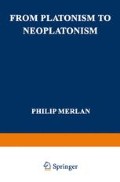Abstract
We saw that the interpretation of the Timaeus became combined with the problem of the division of mathematics. The meaning and importance of this latter division is well known: the quadriparted mathematics is the quadrivium. It is surprising to see how closely the quadrivium is connected with the interpretation of the Timaeus. It is particularly amazing to see that the inclusion of astronomy in the quadrivium made possible the equation soul = mathematicals so as to include the principle of motion in mathematicals. How, we may ask, was this combination brought about? We may also ask: what is the origin of the quadrivium idea?
Access this chapter
Tax calculation will be finalised at checkout
Purchases are for personal use only
Preview
Unable to display preview. Download preview PDF.
References
W. Jaeger, Paideia, v. Ip2 (1945) 316–318.
Cf. W. Jaeger, Paideia, v. III (1944) 257 f. on the study of mathematics in Plato.
The literature on the quadrivium is very great. Its main weakness consists in treating the subject matter as a doxography. In addition to those already mentioned, I confine myself to a few items, with the help of which further references can easily be found. The comparatively large amount of musicological literature is only natural: see below p. 84. M. Guggenheim, Die Stellung der liberalen Kuenste oder encyklischen Wissenschaften im Altertum (1893); C. G. [K. W.] Schmidt, Quaestiones de musicae scriptoribus Romanis imprimis de Cassiodoro et Isidoro (1899), esp. 2 f; 122-25 (basic); P. Abelson, The Seven Liberal Arts (1906); K. Praechter, “Beziehungen zur Antike in Theodoros Prodromos’ Rede auf Isaak Komnenos”, Byzantinische Zeitschrift 19 (1910) 314–329, esp. 322-325; E. Norden, Antike Kunstprosa, v. II (1898) 670 ff. and “Nachtraege” p. 8f. (ed. 1923).
H. v. Schubert, “Bildung und Erziehung in fruehchristlicher Zeit,...” Festgabe... E. Gothein (1925) 72–105, esp. 82-84; A. Schissel von Fieschenberg, Marinos von Neapolis und die neuplatonischen Tugendgrade (1928), esp. n. 169; H.-I. Marrou, Saint Augustin et la fin de la culture antique (1938), esp. 197-210 and 211-235
L. Schrade, “Music in the Philosophy of Boethius”, Musical Quarterly 33 (1947) 188–200.
Author information
Authors and Affiliations
Rights and permissions
Copyright information
© 1953 Springer Science+Business Media Dordrecht
About this chapter
Cite this chapter
Merlan, P. (1953). The Origin of the Quadrivium. In: From Platonism to Neoplatonism. Springer, Dordrecht. https://doi.org/10.1007/978-94-017-6205-2_5
Download citation
DOI: https://doi.org/10.1007/978-94-017-6205-2_5
Publisher Name: Springer, Dordrecht
Print ISBN: 978-94-017-5788-1
Online ISBN: 978-94-017-6205-2
eBook Packages: Springer Book Archive

